Adding floral flavors to your tea blends can elevate your drinking experience in multiple ways. You'll enhance the aroma and complexity of your brew, introducing delicate scents and nuanced flavors that complement or contrast with base teas. Floral elements help balance astringency and create a smoother mouthfeel. Beyond taste, many floral teas offer health benefits, rich in antioxidants and known for promoting relaxation. You can create unique seasonal combinations, experiment with different flower petals, and even pair your floral teas with food. By mastering the art of blending florals, you'll reveal a world of sensory possibilities and potential wellness advantages in every cup.
Enhancing Aroma and Flavor
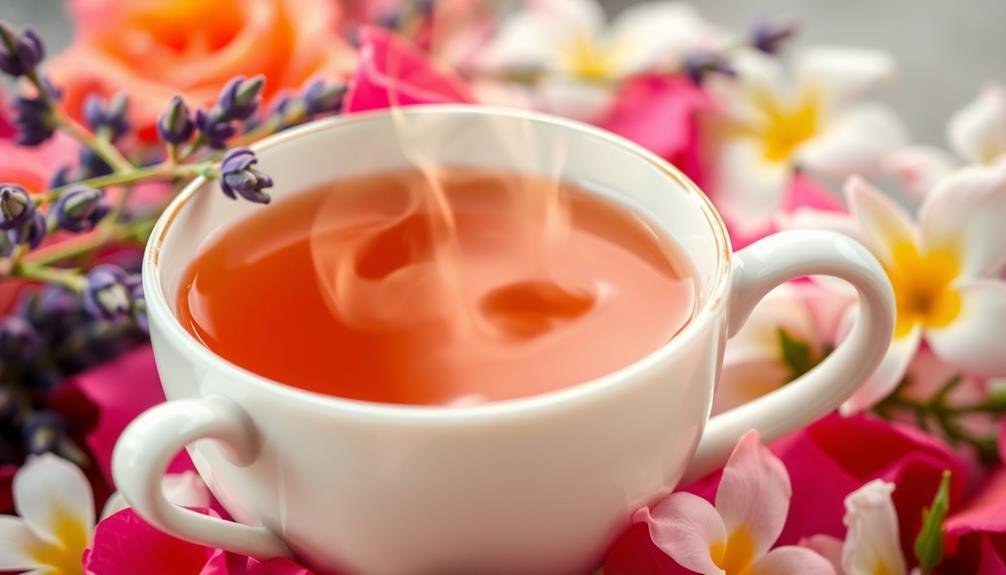
One of the primary reasons to incorporate floral flavors in tea blends is to enhance both aroma and flavor. When you add floral elements to your tea, you're introducing a new dimension of sensory experience. The delicate scents of flowers like jasmine, lavender, or rose can elevate the overall bouquet of your blend, creating a more complex and inviting aroma.
In terms of taste, floral notes can complement or contrast with the base tea, resulting in a more nuanced flavor profile. For instance, adding chamomile to a green tea can soften its grassy notes, while rose petals can bring a subtle sweetness to black tea. You'll find that these additions can transform an ordinary cup into something extraordinary.
Moreover, floral elements can help balance the astringency or bitterness in some teas. They often impart a smooth, sometimes even creamy mouthfeel that enhances the overall drinking experience.
Health Benefits of Floral Teas
You'll find that many floral teas are packed with antioxidants, offering potential health benefits beyond their delightful flavors.
These antioxidant-rich infusions may help combat free radicals and support overall wellness.
Additionally, the aromatic properties of floral teas can have stress-reducing effects, helping you unwind and relax after a long day.
Antioxidant-Rich Floral Infusions
Beyond their delightful aromas and flavors, floral teas boast an impressive array of health benefits, primarily due to their high antioxidant content.
These powerful compounds help protect your body from oxidative stress and inflammation, which are linked to various chronic diseases. When you incorporate antioxidant-rich floral infusions into your tea blends, you're not just enhancing taste but also boosting your overall well-being.
Some of the most potent antioxidant-rich floral teas include:
- Hibiscus: Rich in vitamin C and anthocyanins
- Chamomile: Contains apigenin, a potent antioxidant
- Lavender: High in polyphenols and rosmarinic acid
- Rose: Packed with vitamin C and various flavonoids
- Chrysanthemum: Abundant in flavonoids and phenolic compounds
Stress-Reducing Aromatic Properties
While antioxidants play a vital role in floral teas' health benefits, their stress-reducing aromatic properties shouldn't be overlooked. When you inhale the fragrant steam from a cup of floral tea, you're activating your olfactory system, which directly influences your brain's limbic system – the center responsible for emotions and memory.
Lavender, chamomile, and jasmine are particularly renowned for their calming effects. These floral scents can lower cortisol levels, your body's primary stress hormone, promoting relaxation and potentially improving sleep quality.
Rose petals, often added to blends, contain compounds that may alleviate anxiety and boost mood.
The act of brewing and sipping floral tea can also be a mindful ritual, encouraging you to slow down and focus on the present moment. This practice alone can reduce stress and promote mental well-being.
Additionally, many floral teas are naturally caffeine-free, making them excellent choices for evening relaxation without disrupting your sleep cycle.
Creating Unique Flavor Combinations
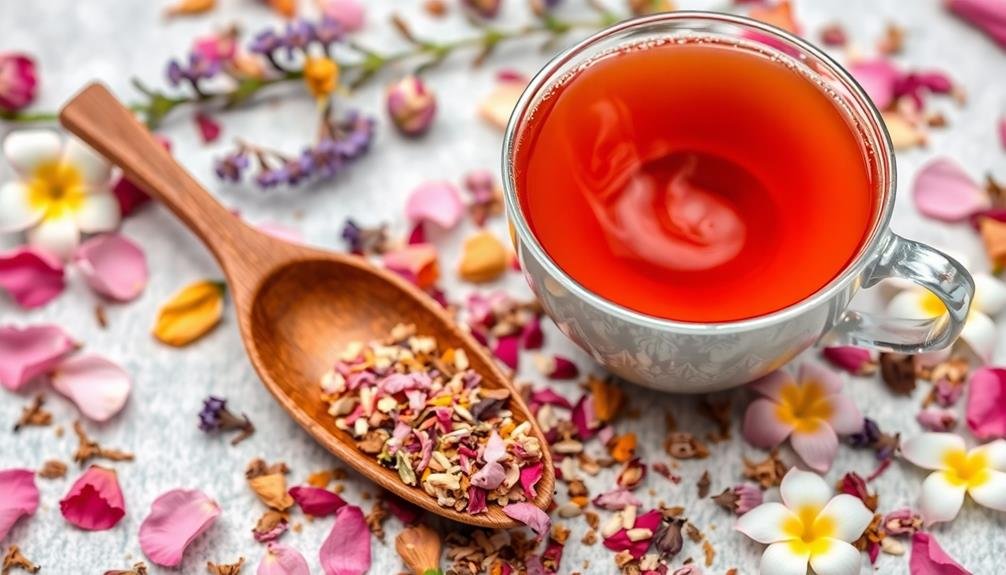
Creating unique flavor combinations with floral teas opens up a world of exciting possibilities for tea enthusiasts. You'll find that blending floral notes with traditional tea bases can result in complex and intriguing flavors that tantalize your taste buds.
By experimenting with different flower petals and tea leaves, you're able to craft custom blends that suit your personal preferences and mood.
Consider these exciting floral tea combinations:
- Jasmine green tea with a hint of lavender
- Rose-infused black tea with a touch of vanilla
- Chamomile and lemon balm for a soothing herbal blend
- Hibiscus and orange peel for a tangy, fruity infusion
- Chrysanthemum and oolong for a delicate, aromatic cup
Don't be afraid to mix and match flavors to create your perfect blend. You can start with a base tea and gradually add small amounts of floral ingredients until you achieve the desired taste.
Remember that some flowers have stronger flavors than others, so it's best to start with a light touch. As you become more familiar with different floral notes, you'll develop a keen sense for balancing flavors and creating unique, personalized tea blends that reflect your creativity and discerning palate.
Seasonal Tea Blend Inspiration
Embrace the changing seasons with specially crafted floral tea blends that capture the essence of each time of year. Let nature's rhythm inspire your tea creations, infusing them with the flowers and herbs that thrive during specific seasons.
In spring, incorporate delicate cherry blossoms and fragrant lavender to celebrate renewal. Summer calls for invigorating hibiscus and chamomile, perfect for cooling iced teas. As autumn approaches, blend warm chrysanthemum and marigold to evoke cozy feelings. Winter's chill pairs well with comforting rose hip and elderflower combinations.
Consider these seasonal pairings for your floral tea blends:
| Season | Floral Notes | Complementary Flavors |
|---|---|---|
| Spring | Cherry Blossom, Lavender | Green Tea, Mint |
| Summer | Hibiscus, Chamomile | Lemongrass, Citrus |
| Autumn | Chrysanthemum, Marigold | Cinnamon, Apple |
Don't limit yourself to these suggestions; experiment with local flora and seasonal produce to create unique blends that reflect your region's natural cycles. By aligning your tea blends with the seasons, you'll offer customers a sensory journey through the year, enhancing their tea-drinking experience with nature's ever-changing palette of flavors and aromas.
Balancing Flavors in Tea Blends
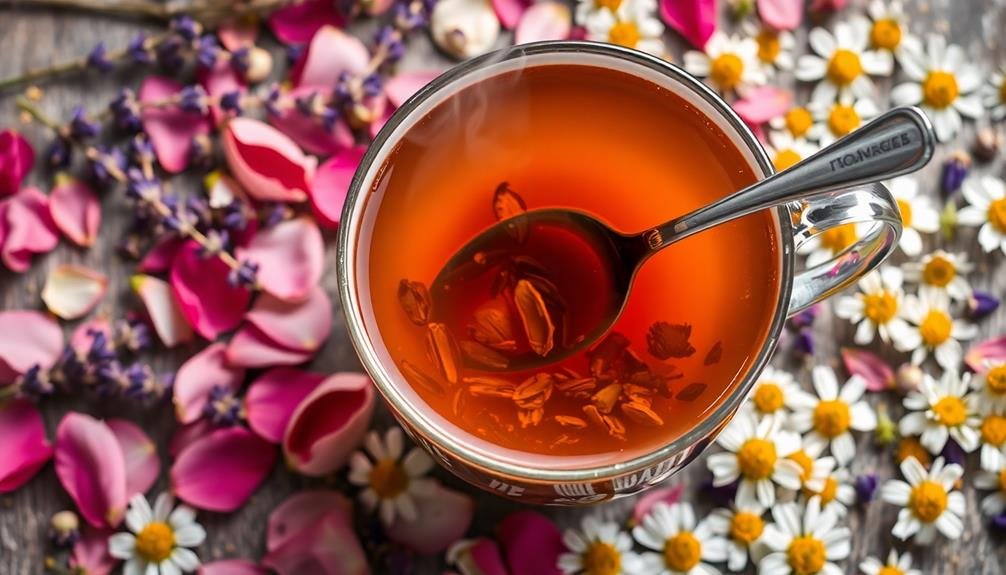
When crafting floral tea blends, you'll need to master the art of balancing flavors.
Start by combining sweet and bitter elements to create depth, then layer complementary notes to enhance complexity.
Combining Sweet and Bitter
The art of balancing sweet and bitter flavors in tea blends is a delicate dance. You'll want to carefully consider how different ingredients interact to create a harmonious taste profile. When combining sweet and bitter elements, start with a base tea and gradually add floral or herbal components to achieve the desired balance.
Here are some tips for successfully combining sweet and bitter flavors:
- Use naturally sweet herbs like licorice root or stevia to counteract bitterness
- Experiment with floral notes like chamomile or lavender to soften bitter teas
- Add dried fruits for a touch of sweetness without overpowering the blend
- Consider the brewing time and temperature to control bitterness extraction
- Balance bitter green teas with sweet white teas for a more mellow flavor
Remember that personal preference plays a significant role in flavor perception. What you find perfectly balanced might be too sweet or bitter for someone else.
Don't be afraid to adjust your blends based on feedback and your own taste tests. By mastering the combination of sweet and bitter flavors, you'll create unique and memorable tea blends that appeal to a wide range of palates.
Layering Complementary Notes
Layering complementary notes in tea blends is a sophisticated technique that elevates your creation from simple to sublime. When you're crafting a floral tea blend, consider how different flavors can work together to create a harmonious experience.
Start with your base tea, then add floral notes that complement its natural characteristics. For example, if you're using a light green tea, you might layer in delicate jasmine or elderflower notes. With a robust black tea, consider adding bolder floral flavors like rose or lavender.
Pay attention to the intensity of each element, ensuring no single flavor overpowers the others. You can also create depth by incorporating multiple floral notes that share similar qualities. Chamomile and chrysanthemum, for instance, both offer soft, honey-like tones that blend seamlessly.
Don't forget to balance floral notes with other flavor profiles, such as citrus or spice, to add complexity and interest. As you experiment, trust your palate and keep detailed notes on your blends.
This will help you refine your skills and develop signature combinations that showcase the best of floral flavors in tea.
Enhancing Aroma Profile
Building on the concept of layering complementary notes, enhancing the aroma profile of your floral tea blend is a key step in creating a truly memorable experience. The aroma of your tea sets the stage for the taste, engaging your senses before you even take a sip.
To elevate your blend's aromatic qualities, consider these techniques:
- Add dried flower petals for visual appeal and subtle fragrance
- Incorporate essential oils for a more intense floral scent
- Use flavored teas as a base to complement your chosen florals
- Experiment with different drying methods to preserve delicate aromas
- Include aromatic herbs to create a more complex bouquet
When enhancing your tea's aroma profile, balance is essential. You don't want to overwhelm the drinker with an overpowering scent. Instead, aim for a harmonious blend that entices without being cloying.
Remember that different brewing methods can affect the release of aromas, so experiment with water temperature and steeping times. By carefully crafting your tea's aroma profile, you'll create a multi-sensory experience that delights both the nose and the palate, elevating your floral tea blend to new heights.
Sourcing Quality Floral Ingredients
When crafting high-quality floral tea blends, sourcing premium floral ingredients is essential. You'll want to focus on obtaining flowers that are organically grown, freshly harvested, and properly dried to maintain their flavor and aroma. Look for reputable suppliers who specialize in culinary-grade flowers and herbs.
Consider the origin of your floral ingredients. Different regions produce flowers with unique flavor profiles due to variations in soil, climate, and cultivation methods. For example, lavender from Provence, France, is renowned for its superior quality and intense fragrance.
When selecting flowers, examine their appearance, color, and scent. High-quality dried flowers should retain their vibrant hues and natural aroma. Avoid flowers that appear discolored, brittle, or have a musty odor, as these may indicate poor quality or improper storage.
It's vital to guarantee your floral ingredients are food-safe and free from pesticides or chemical treatments. Request certificates of analysis from your suppliers to verify the purity and safety of the flowers.
Pairing Floral Teas With Food
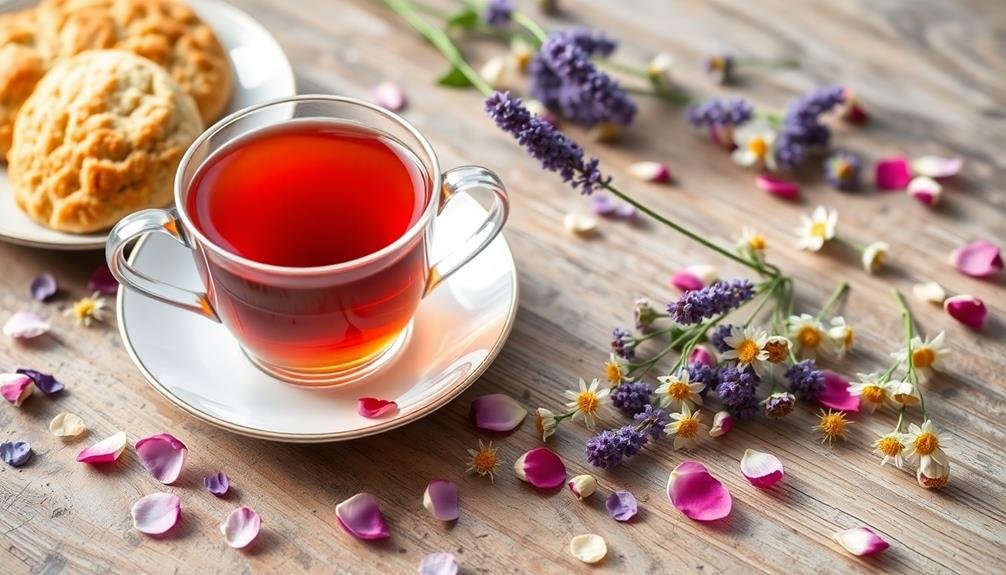
The art of pairing floral teas with food can elevate your dining experience to new heights. When you're selecting a floral tea to complement your meal, consider the flavor profile of both the tea and the dish.
Light, delicate floral teas like jasmine or lavender pair well with mild, subtly flavored foods, while bolder floral blends can stand up to richer, more complex dishes.
To help you get started with your tea and food pairings, here are some suggestions:
- Pair chamomile tea with light desserts like lemon tarts or shortbread cookies
- Serve rose tea alongside Mediterranean or Middle Eastern cuisine
- Complement spicy dishes with cooling hibiscus tea
- Enhance the flavors of fresh fruit salads with a fragrant elderflower tea
- Match chrysanthemum tea with savory dim sum or seafood dishes
Don't be afraid to experiment with different combinations. You might discover unexpected pairings that delight your palate.
Remember that temperature can also play a role in your pairing choices. Hot floral teas can warm up a chilly evening meal, while iced versions provide a revitalizing contrast to spicy or rich foods.
Experimenting With Dried Flowers
Experimenting with dried flowers opens up a world of creative possibilities for tea enthusiasts. You'll find that adding dried blooms to your tea blends can elevate both flavor and visual appeal. Start by exploring common options like chamomile, lavender, and rose petals. These flowers not only impart unique tastes but also offer potential health benefits.
When selecting dried flowers, opt for organic, food-grade varieties to guarantee safety and quality. Begin with small amounts, as floral notes can quickly overpower other flavors. You can mix dried flowers with your favorite loose-leaf teas or create custom herbal blends.
Try pairing jasmine with green tea for a classic combination, or experiment with hibiscus and fruit-based teas for a tart, invigorating twist.
Don't limit yourself to just brewing; consider using dried flowers as garnishes or incorporating them into tea-infused desserts. As you become more comfortable, branch out to less common options like chrysanthemum, elderflower, or calendula.
Remember to store your dried flowers in airtight containers away from light and moisture to preserve their flavors and aromas.
Frequently Asked Questions
How Long Can Dried Flowers Be Stored for Use in Tea Blends?
You can store dried flowers for tea blends for up to a year if you keep them in airtight containers away from light and moisture. They'll retain their flavor and aroma best when stored in a cool, dark place.
Are There Any Floral Ingredients That Should Be Avoided in Tea Blends?
You should avoid toxic flowers like oleander, foxglove, and lily of the valley in your tea blends. Also, be cautious with strong-scented flowers like jasmine, as they can overpower other flavors. Always research safety before using any new floral ingredient.
Can Fresh Flowers Be Used Instead of Dried Ones in Tea Blends?
You can use fresh flowers in tea blends, but it's not recommended. Fresh flowers contain moisture that can lead to mold growth. They're also harder to measure accurately. Stick with dried flowers for safer, more consistent blends.
What's the Best Way to Measure Floral Ingredients for Consistent Flavor?
You'll get consistent flavor by using a small kitchen scale to weigh floral ingredients. Start with 1-2 grams per cup and adjust to taste. Don't forget to record measurements for future blends you enjoy.
Are There Any Potential Allergic Reactions to Floral Teas?
Yes, you should be aware of potential allergies to floral teas. If you're allergic to certain flowers, you'll likely react to their tea counterparts. Always check ingredients and consult your doctor if you're unsure about sensitivities.
In Summary
You've explored the world of floral tea blends and discovered their potential to transform your tea experience. By adding floral flavors, you'll enhance aroma, boost health benefits, and create unique combinations. Don't be afraid to experiment with seasonal inspirations and carefully balance flavors. Remember to source quality ingredients and try pairing your floral teas with complementary foods. It's time to elevate your tea game – start incorporating dried flowers and let your creativity bloom!


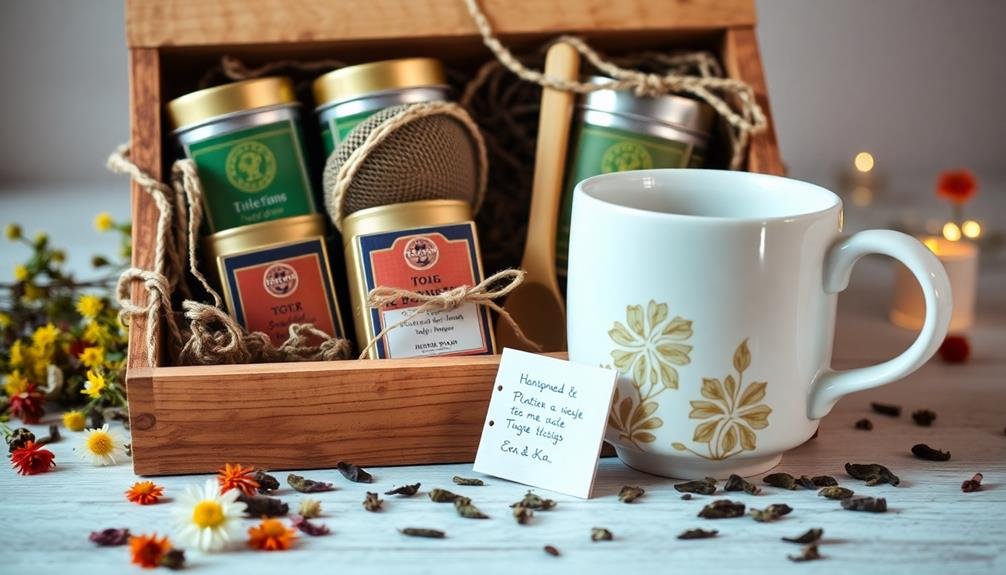
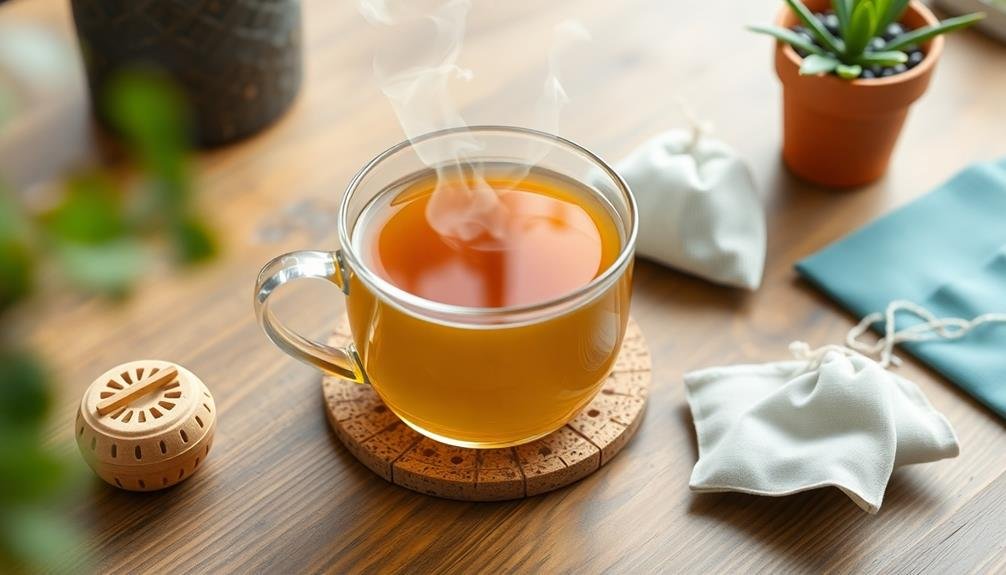
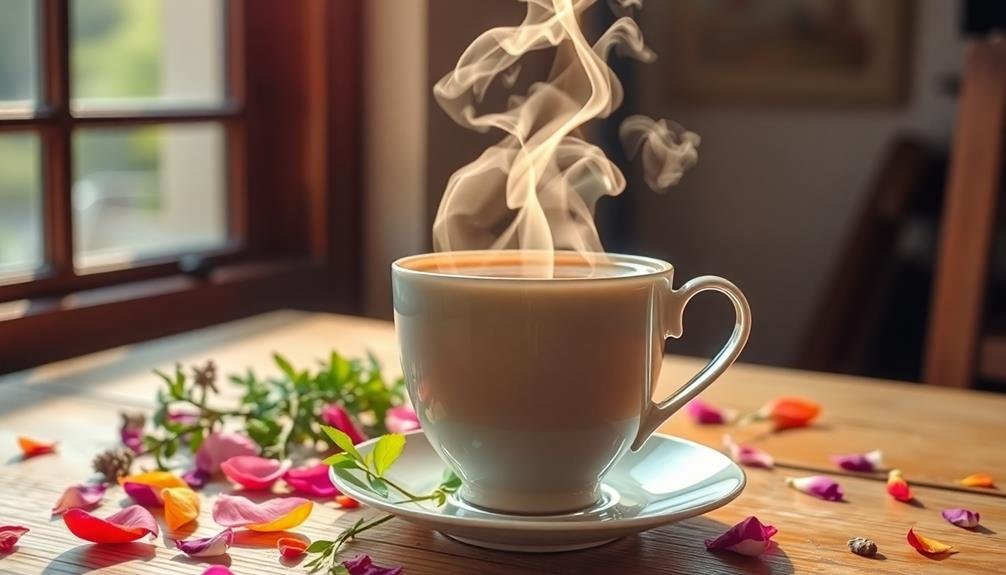
Leave a Reply